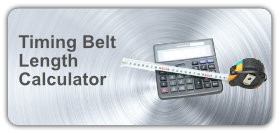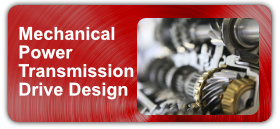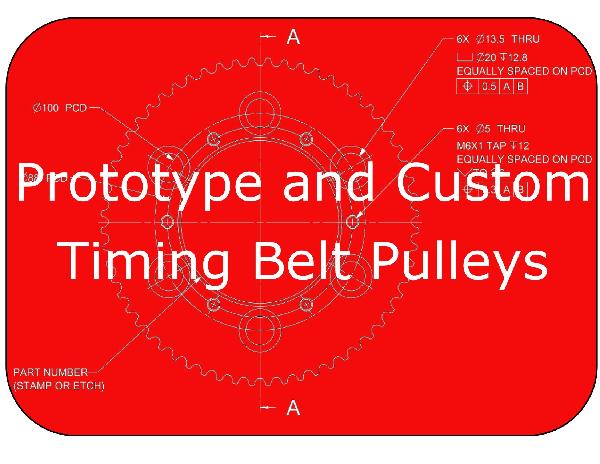Timing Belt Pulley - Belt Guide (Flanges) Guidelines
Timing belts typically track to one side of a timing belt pulley during operation, and would slide-off the timing belt pulley if it was not belt guided (flanged). The tensile cords in the timing belts influence this tracking characteristic and timing belt manufacturers offer tensile cords in alternating twists (S and Z) to try and balance out the tracking.
As each timing belt has its own tracking characteristics, even timing belts with perfect drive alignment can have a tracking problem. Timing belts will have an inherent side thrust while in motion and can be controlled with belt guided (flanged) timing belt pulleys. If the side thrust is to severe, the drive system should be checked for pulley alignment parallel shafts and shaft deflection.
%20Dimension%20Drawing.jpg)
Note:
The timing belt pulley flanges are flared to guide the timing belt better as it runs onto the timing belt pulley. A disadvantage of flat belt guide flanges is that where shafts are not aligned exactly, the timing belt will rub on the inside edge of the belt guide and suffer premature wear. Consequently, we do not recommend using flat timing belt pulley guide flanges.
Note:
Depending on the angle, the outside edge of the timing belt pulley guide flange may not be conform with the face of the timing belt pulley.
Belt Guiding (Flanging) Guidelines:
As each timing belt has its own tracking characteristics, even timing belts with perfect drive alignment can have a tracking problem. Timing belts will have an inherent side thrust while in motion and can be controlled with belt guided (flanged) timing belt pulleys. If the side thrust is to severe, the drive system should be checked for pulley alignment parallel shafts and shaft deflection.
%20Dimension%20Drawing.jpg)
Note:
The timing belt pulley flanges are flared to guide the timing belt better as it runs onto the timing belt pulley. A disadvantage of flat belt guide flanges is that where shafts are not aligned exactly, the timing belt will rub on the inside edge of the belt guide and suffer premature wear. Consequently, we do not recommend using flat timing belt pulley guide flanges.
Note:
Depending on the angle, the outside edge of the timing belt pulley guide flange may not be conform with the face of the timing belt pulley.
Belt Guiding (Flanging) Guidelines:
- Two (2) Timing Belt Pulley Drives – On simple two (2) timing belt pulley drives, either one (1) pulley should be belt guided (flanged) on both sides, or each timing belt pulley should be belt guided (flanged) on opposite sides. For economical reasons, the smaller timing belt pulley is usually belt guided (flanged).
- Multi Timing Belt Pulley Drives – On multiple timing belt pulley drives (i.e. more than two (2) timing belt pulleys, serpentine), either every other timing belt pulley should be belt guided (flanged) on both sides, or every timing belt pulley should be belt guided (flanged) on alternating sides around the system.
- Vertical Shaft Drives – On vertical shaft drives, at least one (1) timing belt pulley should be belt guided (flanged) on both sides, and the remaining timing belt pulleys should be belt guided (flanged) on at least the bottom side.
- Long Span Drives – Timing belts on drives with long spans, typically (8x) times the diameter of the smaller timing belt pulley require both timing belt pulleys to be belt guided (flanged).
- Idlers – Drives using Inside Idlers or Outside (Backside) Idlers are not recommended. However, if need be the idler can be belt guided (flanged) on both sides. This may come in handy on drive systems that do not allow for the timing belt pulleys to be flanged.







